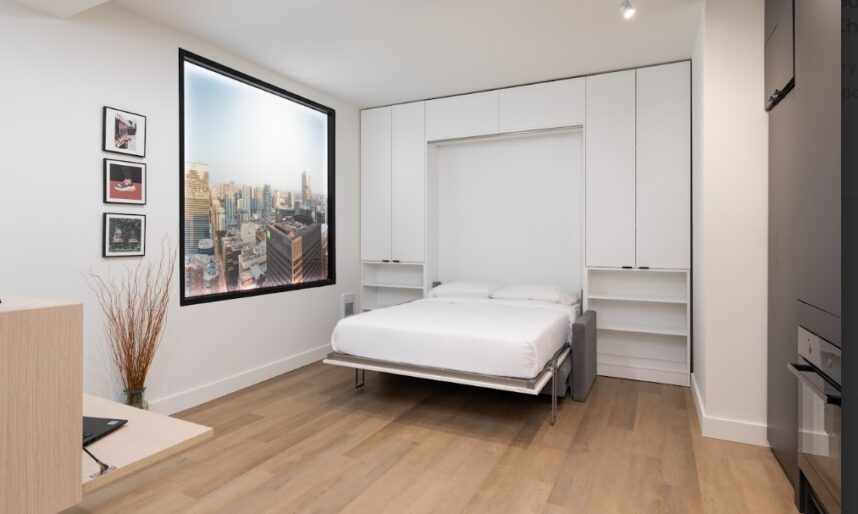Making a case for micro-unit apartments

As housing affordability and climate concerns continue to reach crisis levels in major urban centres around the globe, micro-unit apartments are emerging as a promising, low-cost solution thanks to innovative design concepts improving interior efficiencies. For tenants, the benefits include better privacy and security compared to living with roommates; modern, well-appointed rental accommodations; on-site, all-inclusive amenities; and monthly savings of up to 25 to 40 per cent. From a construction standpoint, the smaller unit-size is more cost-effective compared to larger units, and demand for affordable rental accommodations is only expected to grow.
The question is, are Canadians willing to exist within 300 square-feet of total living space?
“There may be initial concerns for some Canadians, but we believe that with the right approach, micro-units can offer a compelling housing option to young professionals, students, empty-nesters, and individuals seeking affordable urban living,” said Riz Dhanji, President and Founder of RAD Marketing, a real estate development firm in Toronto. “With my 30-plus years of experience in real estate, there has been a noticeable cultural shift towards embracing smaller living spaces, particularly in urban areas like Toronto where affordability and convenience are key drivers for many.”
Recently, Urbanation produced a white paper on behalf of RAD Marketing to investigate the viability of micro-units as a long-term solution to Canada’s housing crisis. Diverse perspectives shared in the report include representatives of the provincial government, housing stakeholders and designers, with renting and owning both considered as options.
According to Dhanji, the consensus is that micro-unit dwellings have a great deal of potential for high-rent cities like Toronto and Vancouver, and any concerns that tenants will reject the small living space are already dissipating thanks to the bigger-picture benefits.
“We’re finding that the end user is placing more emphasis on amenities and location over square footage,” he said. “Developers understand this and are finding more and more innovative solutions to maximizing space. What we’re seeing in all the high-rent cities is that the way people live, and work, is evolving with an increasing emphasis on flexibility, mobility, and sustainability. Micro-units align with these changing lifestyles by offering a low-maintenance, lock-and-leave living environment that complements the modern urban lifestyle.”
 Looking to other markets
Looking to other markets
While yet to take off here in Canada, several major cities in Europe, Asia and the U.S. have already embraced the micro-unit housing model and are reaping significant benefits.
“We have seen this model pop up in high-rent cities such as in New York and San Francisco, addressing the pressing need for affordable housing,” Dhanji said. “We’ve also seen them work in European cities like London and Berlin as a solution to housing shortages. In these markets, the adoption of micro-units has not only addressed housing affordability challenges but also fostered vibrant and inclusive urban communities, demonstrating the transformative potential of this housing model on a global scale.”
It’s no stretch to assume, then, that micro-units would work in a young, vibrant city like Toronto with its growing population of young professionals and in-flux of newcomers seeking rental housing.
“It could help provide a kickstart to their futures, offering an affordable entry point into homeownership,” he said. “Even better, it could help solve the city’s housing affordability challenges while fostering a dynamic and prosperous urban environment for its residents.”
 Technology & innovation
Technology & innovation
Playing a pivotal role in whether micro-units will be embraced here in Canada, design innovation and advancements in proptech are already changing the game. Successful micro-suites will offer seamless ways to maximize space efficiencies, address the challenge of limited square footage, and ensure functionality and comfort while keeping costs to a minimum.
“Technology stands as the driving force behind these advancements, enabling tenants to easily transition their spaces from bedrooms to living areas and beyond,” Dhanji said. “Smart furniture and modular systems are key components of this innovation, allowing for versatile arrangements that cater to diverse needs within a single space.”
Given every square-inch must be usable, the intentional selection of furniture with multiple functions is the cornerstone of micro-unit design.
“Beds that fold into walls, extendable tables, and coverable seating exemplify this approach—but the success hinges on the meaningful engagement of developers, architects, and interior designers,” he points out. “They have no choice but to stay on top of the latest technology and design trends, and continually push the boundaries of what is achievable within the constraints of micro-unit living.”
The path to widespread adoption

In short, Dhanji said he expects the widespread adoption of micro-units here in Canada to materialize within the next three to five years. But getting to that point will rely on industry partners working together to create replicable designs that can be scaled, in addition to support and collaboration from the different levels of government.
“Cooperation with financial institutions and the Canada Mortgage and Housing Corporation (CMHC) would help to catalyze their proliferation, as well,” he said. “Offering options with reduced deposit requirements and CMHC-backed secured financing, along with extended amortization periods, will all contribute to making these units more accessible.”
Lower carbon footprint
Of course, there are several environmental benefits that can’t be ignored, which is another reason other cities are turning to this housing model. By promoting higher density living, micro-unit apartments help preserve natural spaces and reduce urban sprawl, thus contributing to more efficient land use; they also use fewer resources and create less waste compared to larger dwellings, which translates to an overall lower carbon footprint.
At the construction level, micro-apartments require fewer materials and transportation. In fact, according to the 2019 UN Emissions Gap Report, reducing a dwelling’s per capita floor space by 20 per cent could reduce the emissions associated with the production of building materials by 50 to 60 per cent by 2050. It would also reduce heating and cooling demand by up to 20 per cent.
Urban planning and housing policies that encourage more dense and affordable multifamily housing can reduce commuting needs and energy demand. Additionally, higher-density development generates less traffic than low-density development per unit. It makes walking and public transit more feasible and creates opportunities for shared parking. It further minimizes impervious surface area, which causes erosion and polluted stormwater runoff. Pedestrian-friendly, higher density developments offer general health benefits for residents, as well.
For more information on the micro-unit housing model, visit www.radmarketing.ca
The post Making a case for micro-unit apartments appeared first on REMINET.

